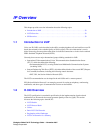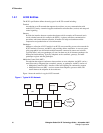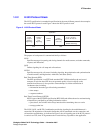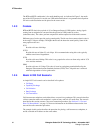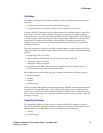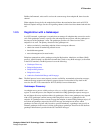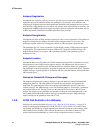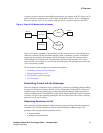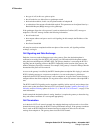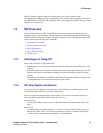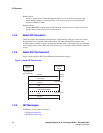Dialogic
®
Global Call IP Technology Guide — November 2007 35
Dialogic Corporation
IP Overview
EndSessionCommand, waits until it receives the same message from endpoint B, then closes the
channel.
Either endpoint (but typically the endpoint that initiates the termination) then sends an H.225.0
ReleaseComplete message over the call signalling channel, which closes that channel and ends the
call.
1.2.5 Registration with a Gatekeeper
In a H.323 network, a gatekeeper is an entity that can manage all endpoints that can send or receive
calls. Each gatekeeper controls a specific zone and endpoints must register with the gatekeeper to
become part of the gatekeeper’s zone. The gatekeeper provides call control services to the
endpoints in its zone. The primary functions of the gatekeeper are:
• address resolution by translating endpoint aliases to transport addresses
• admission control for authorizing network access
• bandwidth management
• network management (in routed mode)
Endpoints communicate with a gatekeeper using the Registration, Admission, and Status (RAS)
protocol. A RAS channel is an unreliable channel that is used to carry RAS messages (as described
in the H.255 standard). The RAS protocol covers the following:
• Gatekeeper Discovery
• Endpoint Registration
• Endpoint Deregistration
• Endpoint Location
• Admission, Bandwidth Change and Disengage
Note: The RAS protocol covers status request, resource availability, nonstandard registration messages,
unknown message response and request in progress that are not described in any detail in this
overview. See ITU-T Recommendation H.225.0 (09/99) for more information.
Gatekeeper Discovery
An endpoint uses a process called gatekeeper discovery to find a gatekeeper with which it can
register. To start this process, the endpoint can multicast a GRQ (gatekeeper request) message to
the well-known discovery multicast address for gatekeepers. One or more gatekeepers may respond
with a GCF (gatekeeper confirm) message indicating that it can act as a gatekeeper for the
endpoint. If a gatekeeper does not want to accept the endpoint, it returns GRJ (gatekeeper reject). If
more than one gatekeeper responds with a GCF message, the endpoint can choose which
gatekeeper it wants to register with. In order to provide redundancy, a gatekeeper may specify an
alternate gatekeeper in the event of a failure in the primary gatekeeper. Provision for the alternate
gatekeeper information is provided in the GCF and RCF messages.





